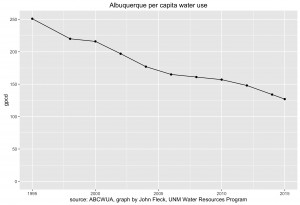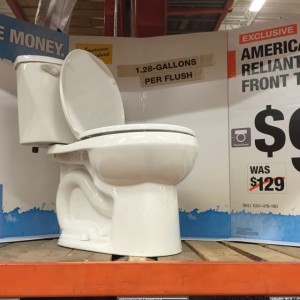
Albuquerque water use
I’m giving a talk next week at the CLE Law of the River conference in Las Vegas about what I think is one of the two most important trends in western water management. The first, which we hear a lot about, is the pressure posed by climate change and drought. The second, which I don’t think gets enough attention, is the remarkable trends in water use by the region’s municipalities. They are going down everywhere. I think this is the salient feature of our water planning and management efforts.
I’ll have to update my slides (that’s a joke – I’ve got a week, you think I’ve started on my slides?) after this morning’s news that Albuquerque’s 2015 water use came in at 127 gallons per capita per day. If you’re not a water numbers nerd, let me try to explain how remarkable that number is. In 1995, Albuquerque residents used 251 gallons per person per day. A major American city has cut its per person use of a critical resource by 49.4 percent in two decades:
“The last time overall water use was this low was in 1982,” Yuhas said. That’s especially impressive when you consider that the Albuquerque population in 1982 was about 366,000 and that the water utility serves more than 658,000 people today.

the 1.28 gallon per flush throne
There’s a lot going on here. On the indoor side, changing national appliance standards and incentives from the Albuquerque Bernalillo County Water Utility Authority mean that toilets, clothes washers, etc., are growing steadily more efficient, both in all new construction and as new fixtures replace new ones in existing buildings.
The real action, though, is outdoors. There, incentives and education by the water utility are entwined with changing community values about what we want Albuquerque to look like. As I wrote a couple of weeks ago, the bulk of those savings over the last two decades have come in outdoor water use, the “consumptive” portion of our water use that we use in our gardens. There is politics and policy here, but all the outdoor savings have been voluntary, a change in behavior and values that is happening one yard at a time.
The outdoor piece matters because indoor water use is fully reused in New Mexico’s middle Rio Grande – we put our treated effluent back into the river where it is available for use by downstream cities, farms, and the river ecosystem itself. When you look at the consumptive fraction, which I think is the most important measure, the outdoor conservation success over the last two decades provides Albuquerque with a remarkable buffer to try to ensure resilience in the face of the threat of climate change to our water supply.

John: Consider that with the human water requirement estimated at 15 gal/person/day, the potential for further reductions in per capita use is great. I also note that with abundant monsoon rains, the need to irrigate is greatly reduced. How does Summer, 2015 compare with 2013?
Steve –
I’ll do the 2015/2013 comparison for you when I have a few minutes, but I don’t think it matters. I know from previous stuff I’ve done that there is a month-by-month signal in response to the weather. But if you look at the overall curve, the decline has been consistent – wet years or dry, the underlying trend swamps the behavioral response to that month’s weather. I think your first point is the most important – we’re nowhere near the bottom if we choose to go there.
The Journal story notes:
I don’t see any upward spikes on the graph, so it must be seasonal spikes?
Since this is per capita use, the number is a construction, calculated by taking the amount of water produced and dividing it by the number of ABCWUA customers. I assume that these numbers would be the amount of water that leaves gages at the pumps and plant, and the number of accounts, respectively. Breaking these numbers down by user type and actual amount gaged at the property, estimated losses due to leaks and ET, and the water rates billed and amounts paid by user type is probably the only way to empirically determine the effect of certain conservation measures and abiotic factors (e.g. drought).
The Journal story notes that a normal water user is at 58 gallons, so these are being balanced by some “non-normal” users and uses that get the average up to 127 gallons. Has there ever been a breakdown that would show the year-to-year average for “normal” water users?
The issue becomes somewhat politicized when we consider decreasing revenues and increasing maintenance costs for ABCWUA. I’m sure we’ll hear more about that soon with a little bit of lag time from the announcement of dropping per capita use.
AE –
The graph’s got some missing years, it’s more spiky at an annual time step. I’ll try to find a version of that and post it.
The number’s based on gages at the individual pump and water treatment plant level, so it’s all water delivered into the system. The denominator is based on the total number of connections of various residential types, multiplied by census data for the number of people per housing unit of those types.
I’m not sure what that 58 means, I think it’s the average residential user?
What’s happened to water rates there? Have the utility’s water sale revenues declined? If so, what has the utility done about it?
Tony – Revenue’s been a big problem. I wrote about this a lot before I left the paper:
http://www.abqjournal.com/413307/abqnewsseeker/bean-counters-at-water-utility-bet-customers-wont-curtail-use-further.html
Part of their approach has been to shift more of the cost to the fixed base cost rather the the volumetric part of the bill. I think this is one of the important questions facing water utilities everywhere.
it is possible to get below 15 gallons per day if you want to do it. switch to dry composting toilets and use all wash/grey water for irrigation. means changing soaps and a few other habits and learning how to compost human wastes, but it’s possible…
the other large and unmentioned water use figures are those used to grow plants and animals, the water used in processing the foods and then the water used during transportation (river barges and other container ships). i suspect these numbers dwarf anything on the municiple side.
Pingback: The struggle with municipal water rates in response to conservation - jfleck at inkstain
Excellent progress for sure!
I currently use about 75 gallons a week. (double in the summer) I certainly conserve, but don’t skimp. Having a composting toilet and very low flow system helps a lot. All the water I use is recycled back into the gardens. (no hookup/cesspool etc.)
Whilst I am an exception, Imagine if the city average was reduced to under 100 gals per week!
Superb. Santa Fe, as you know, has also reduced its per capita water use. For once New Mexico is progressing and what is being done in Albuquerque and Santa Fe hopefully can inspire other cities, especially those in the southwest. Thanks.
Pingback: Debunking Xeriscape Myths